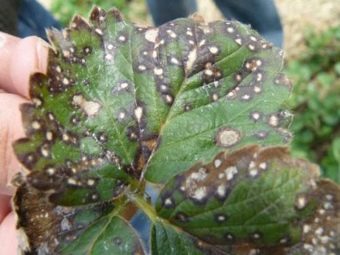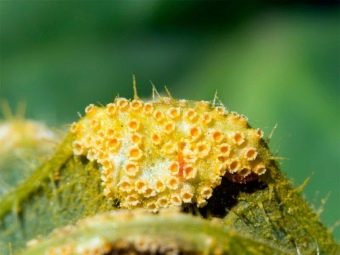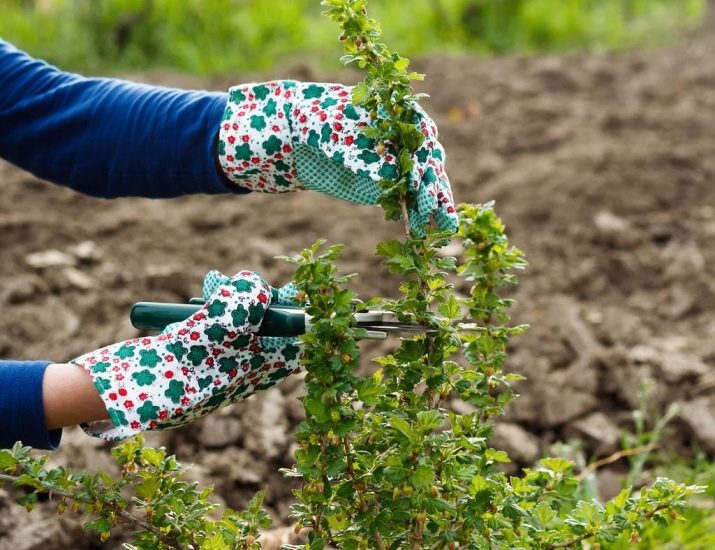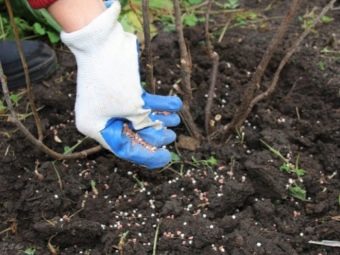Description of gooseberry diseases and methods for their treatment
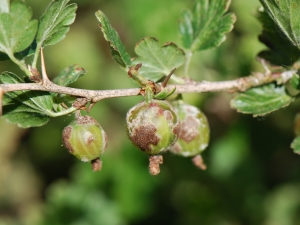
Many gardeners like to grow gooseberries, since most of its species produce a large crop, and the harvested berries can be used to make jam and other equally tasty dishes. But sooner or later, people are confronted with such a problem as diseases that can reduce the yield of a crop or destroy it altogether. It is necessary to ensure that the gooseberry does not become ill with various diseases, as well as to act in a timely manner if this problem does arise.
Common diseases and their symptoms
There are a large number of various diseases of fruit and berry crops. Some of them are harmless, they are quite easy to get rid of. Others are extremely serious, because of which the bush may die. A gardener must know the signs of a lesion and a description of the most frequent diseases in order to determine exactly what kind of ailment he encountered. The symptoms of some diseases are extremely similar to each other, but if you study the plant more closely, you can identify the disease and stop its development and spread to other cultures.
Anthracnose
Fungal disease that affects leafy plates. If the culture is affected by this disease, on the leaves you can see blurred, brown, small dark spots. When the disease begins to develop, its foci (spots) become larger and subsequently disappear altogether, merging into one. Next, the sheet plates dry up, then you can see how the bush dropped them. On the tops of young branches are a few green leaves. If the damage is too strong, the berries also become "spotty" and may peel off.
The first signs of the disease can be seen in July if it rains heavily at low temperatures. Most often the disease occurs in thickened plantings.
If you do not fight the disease, the plant becomes less lush, there is no formation of new shoots, the berries do not ripen, become acidic, most often fall off.
Septoriosis (white spot)
Disease caused by fungus. It affects leafy plates that have round or angular spots of medium size. At the beginning they are brown, with time they become white, a small border begins to appear on them (small brown spots). If the disease is started, they will begin to grow and eventually merge, and dark-colored balls will be on the surface of the lesions.
The sheet plates begin to curl and then fall off. If the gardener ignores the white spot, it will infect not only the leaves, but also the berries, which soon become white and fall off. The disease affects the gooseberries in the spring, feels great in warm and humid weather. Also, its appearance contributes to excessive planting density. If the crop is not treated, the gardener will not have a harvest next year.
Rust
There are two types of the disease: glass rust and columnar rust. At the beginning of the fungus is on the leaf plates, and then on other parts of the culture. The disease is active from late May to early summer. In order for it to begin to develop, high humidity and acidity of the soil is necessary. A gardener may notice large bright orange spots on the leaves. If the disease is not treated, the spots will be transformed into bursting swelling, there are fungal spores in them. The leaf plates shrink, the berries cease to develop, the shoots are bent. In July, the leaves and fruits begin to fall off.
Mosaic
The disease is transmitted by various insects, such as the aphid or mite. Also, the culture may be affected by the disease due to garden tools, which previously worked with infected plants. There are bright yellow patterns that are unevenly arranged near the streaks of the leaf plates. On the affected plant there are no young shoots, the yield becomes low, and if new leaves grow, they are small and wrinkled.
Gray rot
The fungus affects any part of the culture.On young ovaries, at the base of new shoots and leaves, gray dust appears, then it turns into a white fluffy patina, the infected areas begin to rot, mold, and then die off completely. The fruits on such a bush will be watery, the yield will be small, and the plant will also feel extremely bad in winter. Berries can become tasteless and lose their presentation. If the damage is strong, the gooseberry stops growing, then dies.
Gray rot can develop where humidity is elevated. The fungus enters the plant with the help of air, in winter it is in the fallen leaves.
Sphereoteka (powdery mildew)
A disease that infects all parts of the plant. She is active from May to July. In the initial stage of the disease, the grower notices a white patina, similar to a web on the inside of a leaf plate, as well as on the fruits of the gooseberry. In July, the leaves turn yellow.
If you start the disease, coarse seals of brown color appear on the infected areas, the branches become crooked, the leaves become deformed.
Control measures
If the plant is still sick with any disease, you should start timely treatment, because if you ignore the signs of the disease, the shrub may die. If the gardener is faced with white spotting (Septoria) or anthracnose, there are several ways to treat it.
- When the disease begins to manifest itself, the infected shrubs should be sprayed with a solution of copper sulfate (20 grams per 5-liter bucket of water).
- In June, it is necessary to spray the plant with boric fluid (50 grams per half-bucket) or colloidal sulfur (40 grams per half-bucket). Soon the symptoms will disappear.
- Effective drugs to solve this problem are "Hom", "Kaptan", "Ftalan", "Kuprozan" and "Homitsin".
It is necessary to process a gooseberry twice. The first is when symptoms appear, the second is 14 days after collecting the fruits.
- In the autumn, as soon as the foliage was harvested, it was necessary to dig up the soil and process the shrub and the ground under it with a 3% solution of Nitrafen or DNOC. Before the kidneys begin to swell, repeat treatment.
- If the plant is severely affected, you should use Ridomil Gold, Acrobat, Skor, Ordan, or Fundazol. These funds will protect the shrub and relieve them from existing diseases. Preparations can be used only once a year.
If the culture is affected by rust, it is necessary to spray it with a one-percent solution of Bordeaux mixture. Processing should be carried out in several stages. The first time the shrub is processed during the opening of the leaf plates, then - when the buds appear. The last procedure is carried out after the flowers of the plant bloom.
If the damage is significant, the gooseberry should be treated again 14 days after the last treatment.
Mealy dew is a common disease that you can easily get rid of. If the gardener has seen white bloom during the flowering or fruiting period of the plant, it should be treated several times (7-10 days interval) with a solution of soda ash and soap added (5 grams soda, 50 grams of soap, 10 liters of water). Infected shoots and fruits are destroyed. If the symptoms of the disease appeared before the buds opened, it is necessary to spray the bush with fungicides. Soil should be treated with a solution of nitrophene, iron vitriol (three percent) or copper sulfate (one percent). An effective tool in the fight against illness is "Fundazol." You can also use Topaz or Chorus.
Scab is treated with the help of Bordeaux liquid and Fitosporin. There is a disease that is incurable. Mosaic is a disease that causes gardeners to get rid of shrubs.
To avoid the occurrence of this disease, you should pay attention to the symptoms that may indicate attacks by pests that can tolerate it.
Prevention
Experienced gardeners know that it is easier to prevent the occurrence of the disease than to cure the crop from it, so they closely monitor the plant and properly care for it. Preventive measures - that helps to avoid various problems associated with the defeat of the bush diseases, so you should treat the care of the plant more responsibly. It is important to provide gooseberry care in the spring, autumn and summer, because only in this case, the harvest will be large.
- Thickening of the bushes is the reason why most of the diseases occur most often, so you shouldn’t make such a mistake. If damaged, dry or just unnecessary branches are noticed, they must be eliminated.
- Processing shrubs in the fall is very important, so you should collect fallen leaves and burn them outside the garden. It is also necessary to thoroughly dig the soil under the plant. This will help get rid of the fungi that are there.
- Quite often, diseases are carried by various pests, so you should ensure that they do not fall on the bush. Marigolds, garlic, chrysanthemums and dill are plants that cope with repelling many insects. It is necessary to plant them near the gooseberry.
- In early spring, it is recommended to pour hot water over the gooseberries. It helps to destroy the spores of fungi that appear on the plant.
- A variety of fertilizers can improve the immunity of the bush, so do not forget about regular feeding. Improving the immune system also contributes to the processing of gooseberry solution of zircon in the spring. Lack of important trace elements (phosphorus, potassium, nitrogen) can lead to the occurrence of diseases, so you should put them in the soil in time.
If on the bush visible lesions, you should quickly get rid of them. They are carefully removed and burned outside the garden, as fungal diseases can live even on dead parts.
So that the plant does not hurt, it is worth choosing varieties that are highly immune and resistant to a large number of diseases.
Even if the disease is not revealed, it is worth treating the bush twice in a season. For prevention, you must use a solution of potassium permanganate, copper sulphate or Bordeaux mixture. If there are signs of the disease, it is worth using stronger means, one of them is Fitosporin. When choosing a drug, you should carefully study the instructions and strictly follow it, otherwise the plant may die.
It is extremely important to properly cultivate the culture. The first time you need to use the tool no later than two weeks after the disease appeared. If precipitation falls after spraying, repeat it after four hours.
So that the shrub could protect itself, it is better to plant young plants and prune old plants every few years.
Timely pruning is what helps plants grow stronger. If you ignore the old and diseased branches, the shrub may die or cease to bear fruit. A gardener who needs a high yield should do the right thing, and most importantly, perform the procedure in time.
How to feed?
Any culture needs food, so it is important to use various kinds of fertilizers to increase immunity and good growth. In the spring, gooseberries need nitrogen fertilizer. Before the buds begin to bloom, 25 grams of ammonium nitrate or 30 grams of urea per square meter should be added. m plot on which grows a bush.
It is important to remember that potash-phosphate fertilizers are made only a year after the gooseberry was planted. It is best to do this in 2-3 years. It depends on the composition of the soil.
They are worth making in September or October. Half a bucket of rotted manure, 15 grams of potassium chloride or 100 grams of ash and 45 grams of superphosphate are placed in 1 square meter. m of soil. Fertilizers need to be scattered gently, they are placed around the bush.The distance should be two meters from the center of the circle.
The lack of additional feeding affects not only the immunity, but also the general condition of the plants. Because of it, some bushes shed their foliage or even fruit. It is necessary to treat this more responsibly, otherwise the gooseberry will no longer bear fruit or die.
Resistant varieties
To save yourself from unnecessary costs and save your strength, you should acquire varieties of crops that are highly resistant to any diseases. There are many different options, so every gardener will be able to choose exactly what suits him.
- "Neslukhovsky" - is a variety with large fruits, not affected by powdery mildew. Ripens early, is sweet and tasty. In severe frosts, it can freeze, so it is not recommended for the middle zone. Most often, flower buds and shoots are affected.
- "Houghton" and "Spring" - varieties with small spikes and green, sweet fruit, resistant to powdery mildew and other diseases. The shrubs of these varieties are small, so these options are suitable for gardeners who have gardens, the area of which does not allow to purchase a variety with large shrubs. Fruits can be eaten fresh or cooked from them various dishes.
- Negus and African have black fruit. For some, the “Negus” berries can be small, the “African” also pleases gardeners with medium-sized fruits. They are resistant to many diseases.
- "Isabel" - a variety that has a rather large shrub and fruit, in color and taste resembling grapes. Extremely popular and sought-after variety that can independently combat various diseases.
- Fruits "Chernysh" have black color and incredible taste. Mealy dew will bypass the given grade.
- "Seedling Lefora" - extremely early, having a medium-sized bush variety. He has small spikes. Able to survive severe frosts. Fruits are red, large, sweet. It is an excellent option for those who are not able to wait for the moment when the berries are fully ripe. Even slightly immature fruits can strike with their taste.
- Russian Red and Russian Yellow - known varieties with extremely high yield and disease resistance. Experienced gardeners quite often choose these varieties, as they are unpretentious in their care and delight with a large number of juicy and tasty berries.
But it is important to remember that even if the variety is highly resistant to diseases, it is necessary to take care of the plant, otherwise all works will be meaningless. The forces invested in care and care will be recouped by high yields and good growth and development of gooseberries.
This is an extremely unpretentious culture that quickly cope with diseases and continues to delight gardeners with tasty fruits. So that positive emotions from growing a bush are not overshadowed by the occurrence of diseases, you should carefully monitor it and do everything to ensure that such problems bypass the garden.
How to treat gooseberries, see the video below.







